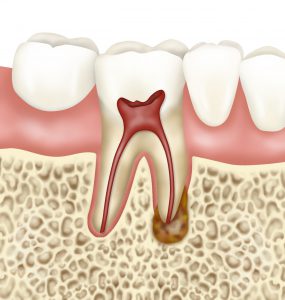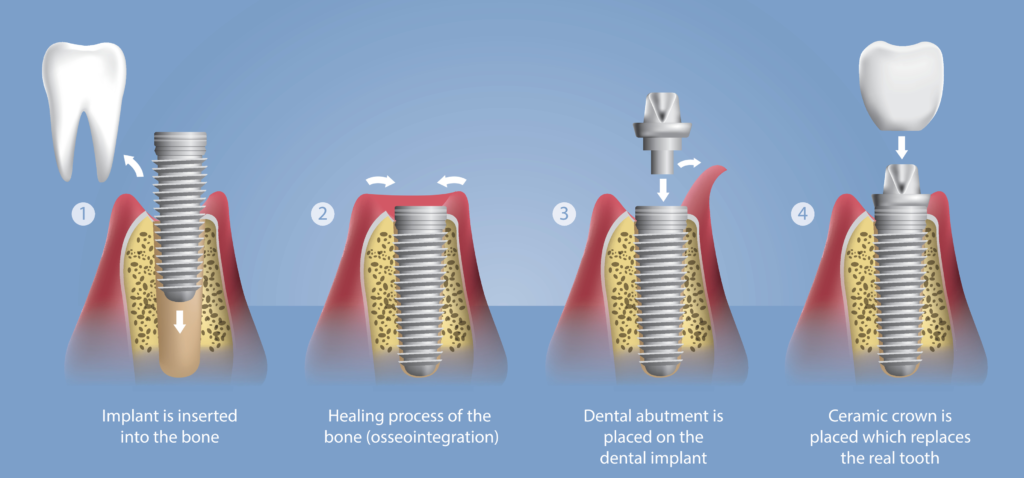implants & bone grafts
Non-Restorable tooth

A natural tooth consists of a root and a crown. If you compare natural teeth to implant-supported replacement teeth, you’ll see they have the same basic parts. Both have a crown (the visible part used to chew food). Both have a root that holds the tooth securely under the gum and is anchored into the jaw. The difference is that the implant is made of titanium – the same time-tested material used by surgeons for artificial joints. When you lose a tooth, you lose both the root and the crown. To replace the tooth, the surgeon first replaces the root with a small dental implant.
- Restore missing tooth without affecting adjacent tissue
- Possible immediate implant with extraction
- Temporary prosthesis for cosmetic benefit
implant supported restoration

Time is allowed for bone to heal and grow around the dental implant. The bond bonds with the titanium, creating a strong foundation for artificial teeth. A support post (abutment) is then placed on the implant and a new replacement tooth (crown) is placed on top of the abutment. In many cases a temporary replacement tooth can be attached to the implant immediately after it is placed. If all your teeth are missing, a variety of treatment options are available to support the replacement teeth.
- Ability to supported fixed, hybrid or removal prosthesis
- Prevents bone loss and adjacent teeth migration
- High success rate with great long term prognosis

The implant can be placed with adequate bone. Sometimes at the time of extraction with enough bone, immediate implant placement can be completed. When there is not enough bone, bone grafting procedures are completed prior to implants.
After the implant is placed, a healing period which we refer to as “osseointegration” will be needed for at least 3 to 6 months or even longer depending on your health. During this time your bone will naturally grow around the implant, securing it in place.
We refer to this as a “second stage” procedure which can be done just under topical and/or local anesthesia. During this stage a “healing abutment” will be placed on top of the implant to shape the gums in order to get is ready for the eventual crown.
Approximately in one month, after your gums have matured around the healing abutment, you will see the general dentist, where an impression will be taken of your implant in order for them to create a custom made crown that will screw into your implant.

After dental extraction or loss of tooth, naive bone is loss over time. Bone grafting is a surgical procedure designed to regenerate and rebuild bone and supporting tissues. One of the most common reasons for undergoing bone grafting is for dental implants. As small titanium posts must be inserted in the jaw bone, it’s important to have sufficient bone. A bone graft can be taken from donor bone, from synthetic bone, or directly from the patient’s own healthy bone. It creates a foundation for the growth of new, living bone.
Bone grafting procedures can sometimes be done at the same time as a dental extraction or other procedure to make the process as efficient as possible. Generally, a bone grafting procedure involves placing bone graft material in areas where the bone is too sparse. The bone graft material consists of tiny granules of bone suspended in a gel. The bone granules can come from another part of your body or a tissue bank.
Bone grafting is effective at increasing the width and height of the jawbone, and can repair defects in the bone. The procedure can also help to stabilize and restore the foundation of the jaw before another dental procedure is performed, such as dental implant surgery. Following periodontal disease, tooth extraction, or other invasive procedure, bone grafting can help prevent bone loss.

Autogenous bone transplantation is the process of harvesting bone from your body and transferring it to the area of deficiency to accommodate implants restoration. Often autogenous graft is indicated for severe bone resorption, allograft (cadaver) is unable to adequately establish sufficient bone required for implants. The diagram is showing harvest of bone from the ramus, a common intra oral harvest site.
It's time to replace that missing tooth
Dental implants are the most optimal treatment for edentulous space. Dental implants provide a foundation for replacement teeth that look, feel, and function like natural teeth. The person who has lost teeth regains the ability to eat virtually anything, knowing that teeth appear natural and that facial contours will be preserved. Patients with dental implants can smile with confidence.
